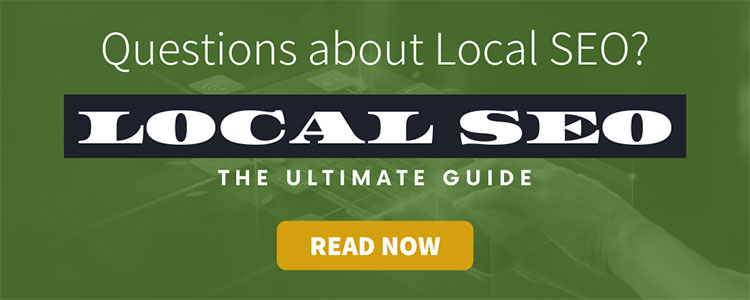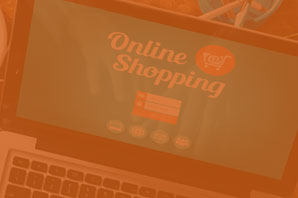A brick-and-mortar business still needs a web presence — whether you’re trying to sell your product digitally or not. Today, the most successful retail stores run comprehensive digital marketing campaigns, designed to draw attention from around the globe and from customers right next door. Digital marketing in the retail sector is much different from those select few successful stores.
“Are you doing digital marketing?”
We’ve asked this question to hundreds of retailers over the last year. The answers we get vary but the theme is much the same. “We’ve got someone handling our PPC.” While that’s great to hear as marketers, there is a big piece missing.
Think of it this way…
Digital Marketing is like Thanksgiving Dinner. You’ve got turkey, stuffing, sweet potatoes, vegetables, pumpkin pies, cranberry sauce, and all the little custom dishes that make your buffet special for your guests. When we hear retailers answer our question above with, “We’ve got someone doing our PPC” it’s a lot like saying, “We are serving cranberry sauce.” It’s a great part of the buffet but it’s just one part.
Through the right digital marketing campaign, retail stores can develop relationships with their communities, forge stronger ties with their customers, and identify otherwise potentially missed opportunities. The most effective retailers are multi-dimensional with their digital marketing all at once. They use SEO, PPC, Email marketing, Social marketing, Content marketing and more. How much of the buffet are you serving your audience?
Digital Marketing Strategy
 Before you begin your marketing campaign, you need to know what your goals are. Do you want to increase your company’s revenue? Reach out to potential customers who may not yet have heard about your brand? Do you want to target specific audience demographics, or do you want to build trust with a specific type of buyer? Your strategy is going to drive the actions you take and the metrics you track.
Before you begin your marketing campaign, you need to know what your goals are. Do you want to increase your company’s revenue? Reach out to potential customers who may not yet have heard about your brand? Do you want to target specific audience demographics, or do you want to build trust with a specific type of buyer? Your strategy is going to drive the actions you take and the metrics you track.
It needs to include:
- Customer demographics.
- Business Goals
- Your timeline.
- Digital marketing budget.
Once you know what you want to accomplish, then you can settle on how to accomplish it. Often, this requires some level of trial and error, as you break into the market and learn more about what your customers expect. Your strategy is going to evolve over time, but having a firm foundation matters.

Email Marketing
Pros
- Direct: You can email individuals who have already shown an interest.
- Sustained: You can develop relationships with those on your newsletter over time.
- Segmented: you can deliver unique messages to specific groups
Cons
- Filtered: Many people filter out emails they view as being potentially “spammy.”
- Time-consuming: It can take some time to develop valuable email messaging.
As a business owner, you probably check your email multiple times a day. How often do you find deals from vendors or other interesting information that you need to look into? From community events to one-off sales, being informed about your community is often how you make money.
Consumers check their personal and work emails multiple times a day, looking for community news, events, and sales. To establish your retail presence, you can send them important information about what’s trending in the industry. Over time, you can use this to build personal authority; customers will be more likely to look to you as a resource if they find that you often have important information about their hobbies or interests.
An example: consider a furniture retailer that sends out regular information about furniture styles, fabrics, and design tips. Customers are likely to follow this shop not just because they’re interested in their products, but also to find out more information about new styles and trends. It’s incidental that they’ll also get information about sales and coupons — but when they do get this marketing information, they’ll be more likely to capitalize on it because they already trust the store.
This is how digital marketing in retail sector locations works — by building trust and authority. Over time, customers learn to trust you and are more willing to visit your space.
Social Media Marketing
Pros
- Affordable: You can start building a social media account with nothing invested but time.
- Buildable: Over time, your social media influence will grow as you gain more followers.
Cons
- Distracting: Managing a social media campaign can take a lot of time day-to-day.
- Unpredictable: You may not be able to tell which campaigns will lead directly to conversions.
Social media marketing is no longer optional for most businesses. In fact, before consumers visit a shop at all, they’ll often check their social media accounts. Social media is used to show everything from menus for restaurants to the “open hours” for retail locations. A customer who doesn’t see a social media page for a business could even assume that the business is closed or that it hasn’t opened yet — that’s how prevalent social media has become.
Social media also has the advantage of letting you communicate with your customers one-on-one. Your customers can contact you if they experience any problems at your shop — or if there are items that they’d like you to start carrying. The benefits of this type of constant communication with your customers are immeasurable. You can develop a rapport with your customers, create relationships within your neighborhood, and encourage customers to come in.
Platforms such as Facebook also make it easy to organize and plan events, to draw customers into your store who otherwise might not visit.
You can also pay for marketing directly on social media platforms. This often comes in the form of “promoted” or “boosted” posts, which will be shown more frequently than your regular posts. This is important because many platforms, such as Facebook, have been reducing the visibility of commercial postings. Promoted and boosted posts can be targeted to very specific audiences. As an example, a Facebook post can be targeted to “people with friends who like HGTV,” or “people who are interested in power motion recliners.”
Content Marketing
Pro
- Long-lasting: Content marketing will continue building your influence over time.
- Branding: Content marketing enhances brand awareness and perception of your business.
Con
- Involved: Content marketing does require marketing research and a substantial upfront investment.
- Broad: Content marketing may not always be as targeted as other forms of advertising.
Content marketing can take many forms, but the most popular type of content marketing is blogging. Through blogging, you create a repository of valuable, timely content that your current and potential customers will be interested in. Consider again the retail furniture store. A retail furniture store my post information about “decorating your college apartment,” “staging a home for sale,” or “finding the perfect mattress.” An outdoor furniture store may write articles specifically about “caring for outdoor furniture.”
All of these things are things that their potential customers may be interested in. As people search for these topics, they’ll be drawn into the retail furniture store’s website — and they’ll learn more about the retail furniture store’s products. It also works hand in hand with SEO.
SEO (Search Engine Optimization)
Pro
- Broad: SEO has a wide reach that can extend the perception of your brand.
- Active: SEO can bring in customers with ongoing activity and updates to the SEO on your website.
Con
- Time-Consuming: It’s great to have a project like ongoing SEO to keep bringing in new traffic and leads. But it takes a lot of experience, attention, and time to do SEO.
- Difficult: Depending on your market, developing a solid SEO campaign can require substantial experience and insight.
We talked about a blog earlier, but how are customers finding that blog? They’re finding it through search engines — and only if the “search engine optimization” is done correctly.
When customers are looking for something specific, they enter in a search query for it in a search engine. This search query is often something like “furniture retailer in New Jersey.” Understanding how customers search for your products and services is important, especially when you’re creating a blog or building out your website.
As a retail space, you want your customers to find you whenever they’re looking for a product or service that you have in their area. A retail furniture store doesn’t want to just show up when someone is looking for “furniture in Connecticut.” The store also wants to show up for search phrases such as:
- sectionals in Connecticut
- choosing the right couch
- matching your furniture to your decor
- upholstering old furniture
And so forth — the store wants to connect with customers who are looking for things that are related to furniture as well. And, of course, there is an emphasis on connecting with customers who are in their geographic location.
SEO often goes hand-in-hand with content marketing, and you can see why: it often revolves around providing content shaped around these search engine terms. However, it also goes much deeper; it goes into analyzing with search queries are most popular, how often key terms need to be repeated, and which variations of these key terms must also be used.
PPC
Pro
- Fast-acting: A PPC campaign often begins bringing in traffic immediately.
- Targeted: Most PPC companies give you substantial ability to filter out your audience.
Con
- Expensive: PPC campaigns can be very costly, if not well-optimized.
Content marketing and SEO are one side of the coin: PPC is the other. PPC stands for “pay per click,” and is often used to generally describe advertising strategies in which you pay for your website to be shown or your social media content to be promoted. In the old days, many campaigns were “PPI” (pay per impression). Which means that every time a user sees your ad, the platform (like Google) charges you. Today, most campaigns are PPC: you pay only when a user clicks through your ad to see more.
Pay-per-click advertising is useful hand-in-hand with organically built traffic. Of course, the obvious downside to PPC campaigns is that you do need to pay for them: they don’t come free, the way that organic traffic often does. PPC advertising is used to build traffic when you first launch a marketing strategy and can be used to augment your traffic for special events and promotions. It can also be used to build a following on social media.
Analytics in Digital Marketing
With as many digital marketing in retail sector strategies as there are, the most important aspect becomes analytics. Analytics involves the collecting and reviewing of your marketing data to see which strategy is working and whether your marketing metrics are improving. Some common metrics include:
- The amount of traffic your website is getting, compared to traffic to your retail store.
- Number of visits your content is getting, as indicates what your customers are most interested in.
- Total engagement your posts are getting on social media, indicating a general interest in your products and services.
Your analytics show you whether your campaigns are improving or declining and whether there may be areas that you need to focus on more. You may find that your customers are more interested in one area of your business than others, or that they may be more apt to follow your newsletters or social media accounts if you deliver a specific type of content.
Tools to Improve Digital Marketing in Retail Sector
Getting started with digital marketing in the retail sector can seem overwhelming, but there are tools that can help. Here are some simple tools that you can use to make the process easier.
- BufferApp. Buffer lets you queue up posts for social media accounts, to make the process of managing multiple social media accounts easier.
- HootSuite. Similar to Buffer, HootSuite allows for the management of multiple accounts. It also has advanced features, such as raffles and surveys.
- Yoast. If you want to refine your SEO, Yoast can help. Yoast offers WordPress plug-ins and a standalone product.
There you have it. That’s everything you need to know about digital marketing in retail sector businesses. Though it’s by no means comprehensive — marketing is an extremely complex discipline — it covers the basics of what you need to know. Now you just need to get started.





